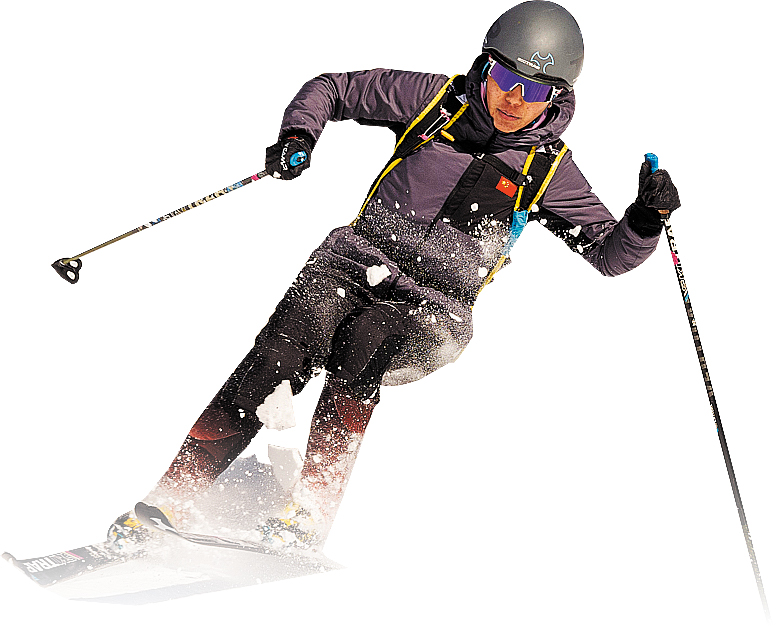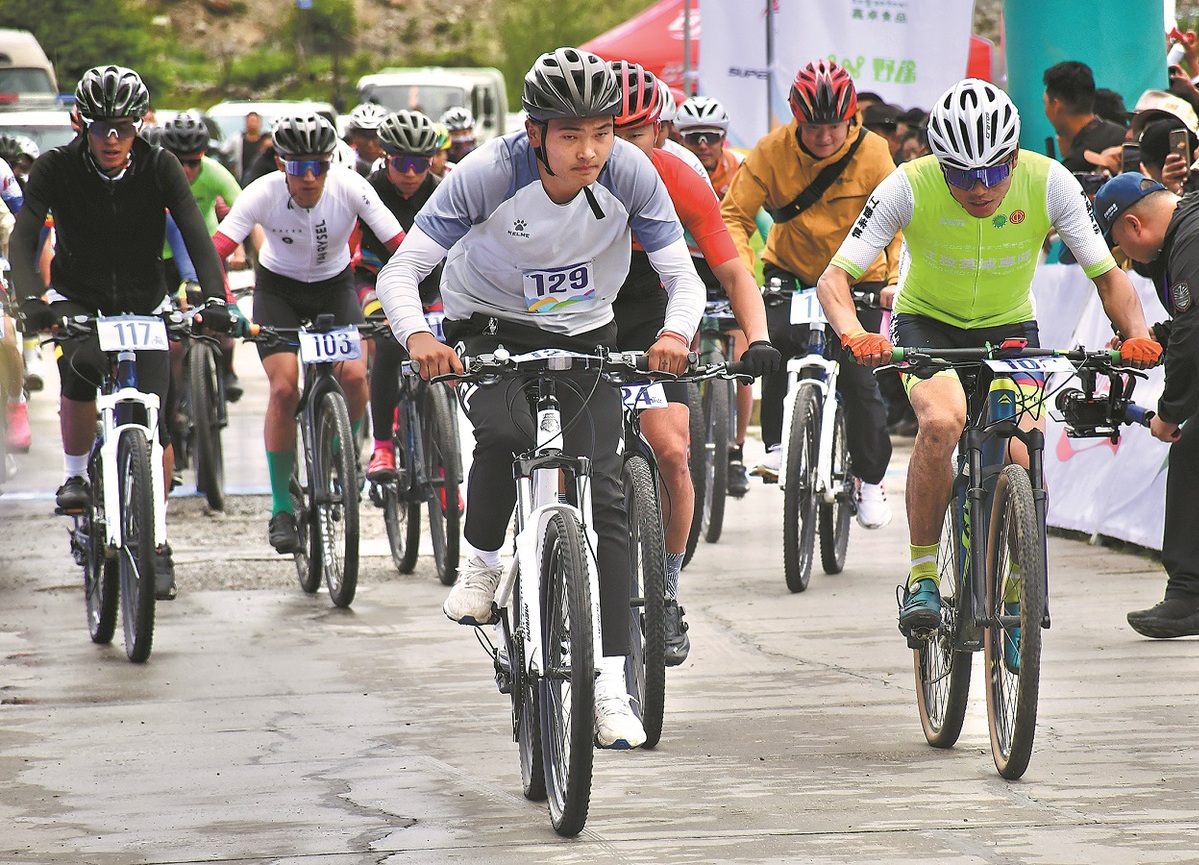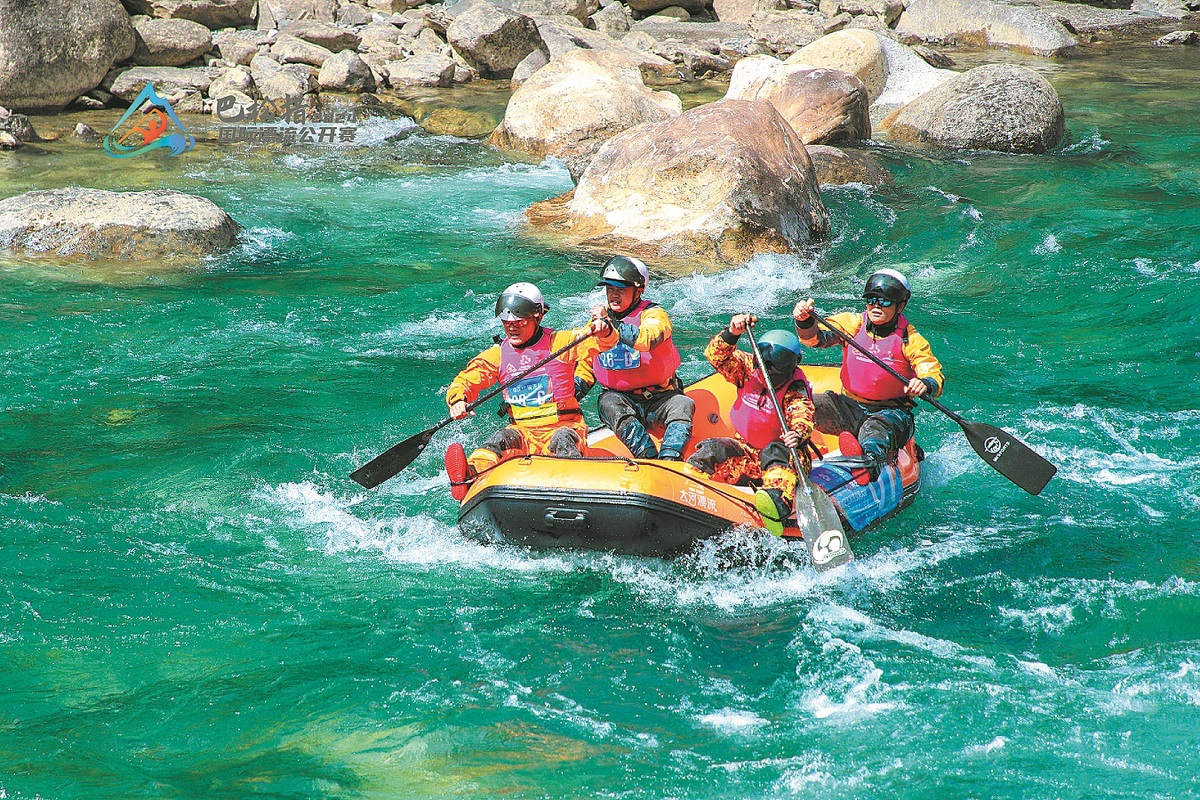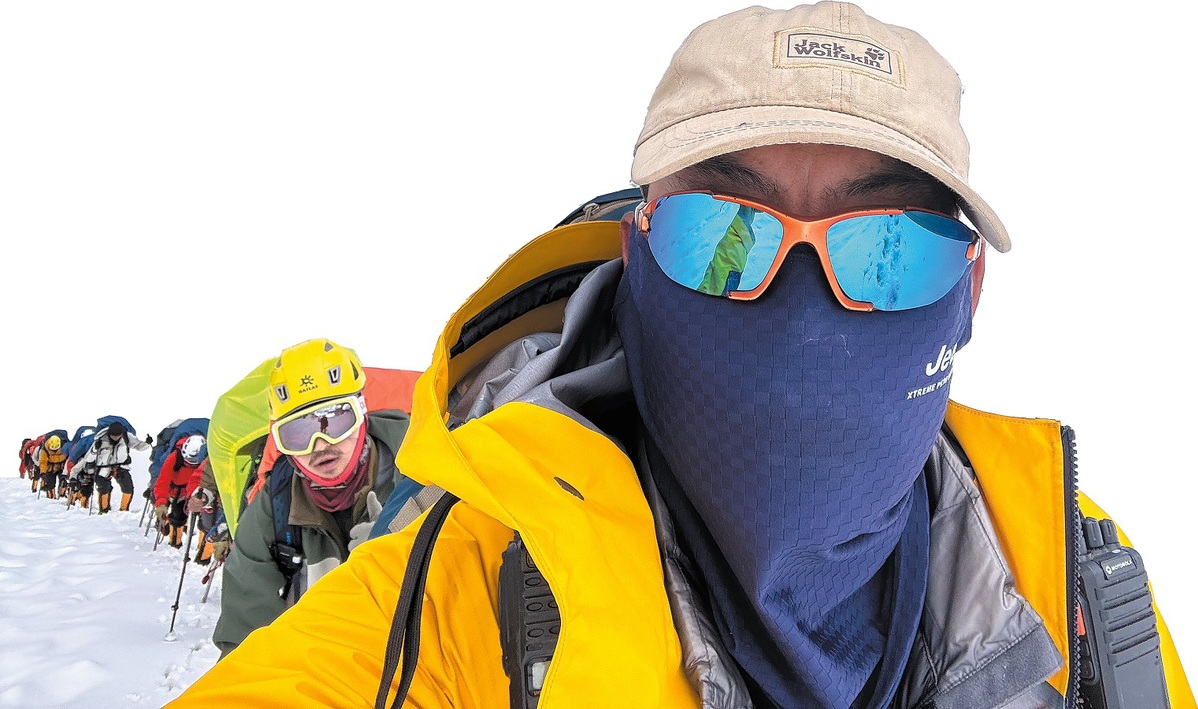By PALDEN NYIMA and DAQIONG in Lhasa Source:China Daily 2024-08-01

Tibetan skier Yudron Lhamo is an emerging mountaineering athlete who won China's first world championship in the sport last year. [Photo provided to China Daily]
With its stunning landscape and soaring mountains, the Xizang autonomous region is rapidly developing its massive potential as a destination for climbers and other outdoor sports enthusiasts.
Seasoned climber and guide Ngakwang Dorje, 41, established an outdoor sports business more than a decade ago and is ready to ride the coming tourism wave.
Born at the foot of Qomolangma, the world's highest mountain, which is known as Mount Everest in the West, he spent the early part of his life herding animals and traversing the region.
At 18, he was selected to train as a professional climber at Xizang's mountaineering guide school in Lhasa, the capital of the region.
After years of training, he emerged as a top climber and certified mountaineering guide, and has scaled the 8,848-meter summit of Qomolangma several times. He has also conquered many mountains above 7,000 meters in the region.
In 2013, he co-founded the Xizang Snow Eagle Alpine Outdoor Sports Co, which offers a range of outdoor activities including climbing, hiking, trekking, and vehicle tours. "We expect more people, especially younger generations, to engage in outdoor sports in Xizang, not just wealthy people from coastal cities or abroad," he said in an interview with China Daily.
Conquering Xizang's towering mountains is high on many visitors' agenda, but there are safety restrictions involved, he said.
Climbers targeting peaks above 5,000 meters in the region, have to apply for a permit in advance, according to the General Administration of Sport and the sports bureau of Xizang. Applications need to detail each climber's personal information, proposed climbing routes and related plans.
Outdoor sports companies such as Xizang Snow Eagle can organize expeditions for Chinese nationals on mountains not exceeding 8,000 meters. Potential climbers are vetted for their mountaineering experience and physical capabilities. The mountaineering events above 8,000 m organized by the authorities would also invite international professional mountaineers.
Climbers cannot proceed beyond certain levels, such as 6,000 m, unless they prove themselves capable at lower levels, Ngakwang Dorje explained.
He knows full well the potential danger on the ice and snow.
In the autumn of 2008, he was climbing Mount Shishapangma when he slipped from a snow bridge and dangled from a rope ladder in midair for a few minutes. "I was frightened at first, but I gradually calmed down under the encouragement of my partner Tsering Dondrub," he said.

Competitors take part in the cycling leg of an ironman triathlon in Kongpo Gyada county, Nyingchi, Xizang autonomous region, in July. [Photo provided to China Daily]
Optimistic outlook
In recent years, the regional sports bureau and the local mountaineering association have provided support for the growth of outdoor companies. Between 2021 and 2023, the government gave them free office space and training areas.
There are about 10 outdoor sports companies in the region operated by locals and staffed by graduates of the mountaineering guide school, said Chen Ming, a spokeswoman for Xizang Snow Eagle. The school has trained more than 200 locals in recent decades, she added.
The development of outdoor sports in Xizang was discussed by domestic and international participants at the 4th China Xizang Trans-Himalaya Forum for International Cooperation held in Nyingchi in early July.
Pan Shihua, assistant to the president of the China Sports Industry, said at the forum outdoor sports can become a new engine to drive the local economy.
The region is rich in outdoor sports resources, including high-altitude snow-capped mountains, pristine forests, lakes and grasslands, he said.
Xizang has the potential to become a global destination for outdoor sports, and Pan believes it should focus on establishing itself as a world-renowned mountain sports destination. This could be achieved by hosting international and domestic mountain sports competitions.
Serge Louis Koenig, foreign affairs director of the National School of Mountain Sports in France, told the forum that Xizang had the world's greatest mountains, a vast territory, varied and well-preserved natural resources, and vibrant local traditions. These, coupled with ongoing socio-economic development, made the region a "promising breeding ground" for outdoor sports, he said.
While the mountains in Xizang are higher than the Alps in Europe, this could help authorities maintain the pristine environment while developing the outdoor sports industry.
"The land here is much higher, but it is perhaps also an advantage to naturally limit mass tourism with its negative impacts, particularly on the environment," Koenig said.
He suggested diversifying leisure activities across all four seasons to meet a wide range of recreational demands.
Camping, rafting, skiing, hiking, and other activities have consistently ranked high in online search popularity since 2022, according to the online travel platform Mafengwo.
According to data from the Chinese online travel agency Ctrip, in the first half of 2023, the volume of orders related to outdoor sports increased by 79 percent compared with the same period in 2022.

A team competes at the Basum Tso International Rafting Open in Konpo Gyada county in April. [Photo provided to China Daily]
Touching the sky
Businesswoman Wang Xueyi, 28, from Shenzhen, Guangdong province, joined an organized three-day hiking trip near Mount Kulha last week. She said it had been a long-term dream of hers to experience the wild beauty of Xizang firsthand.
"The landscape in Xizang is very beautiful, with endless blue skies, white clouds, colorful prayer flags, sacred snow-capped mountains, and jade-like lakes," said Wang.
"In people's minds, Xizang is far away and hard to reach, but many people desire to go there," Wang said.
She was also impressed by the cultural and religious aspects of the region.
"The clouds seem within reach," she said. "The rocks are perilous and towering, the snow-capped mountains are pure, white and sacred. Although the altitude can be challenging, I felt very happy experiencing the vastness and magnificence of Xizang," she said, adding she plans to return to Xizang after her positive experience.
Guide Ngakwang Dorje said Tibetans respect and worship the high mountains as they are considered sacred and must be protected. While providing outdoor services generates an income for locals, sharing an understanding of their significance with visitors is equally important, he said.
Instead of "conquering" a sacred mountain, a Tibetan would walk around it in a clockwise direction as a religious observance to ask for protection from the mountain gods, Ngakwang Dorje said.
"Climbers from the West and people from other parts of China have a desire to conquer the mountains by reaching the top, this is very different from our belief," he said.
"For us, all the climbing and all the work we have been doing is all a job."

Seasoned climber and guide Ngakwang Dorje leads a climbing expedition. [Photo provided to China Daily]
Peak performance
Xizang is also proving a rich breeding ground for homegrown talent in mountain sports.
In recent years, the Chinese National Mountaineering and Skiing Team has selected an increasing number of young athletes from Xizang, training them to compete in various competitions. Approximately 10 young athletes from the region account for roughly half the national team, said Nyima Tsering, head of the regional sports bureau. Ski mountaineering, which combines snow mountain climbing with skiing techniques, will make its debut at the 2026 Winter Olympics.
Tibetan athlete Yudron Lhamo has emerged as China's ski mountaineering sensation by winning multiple medals at international ski mountaineering competitions in recent years.
Her victories include dominating the U20 women's sprint category at the International Ski Mountaineering Federation World Championships in Spain last year to become China's first world champion in the sport.
"I think that Tibetan athletes hold their greatest advantage in terms of willpower and endurance in winter sport," said Yudron Lhamo.
An official ski team was established in the region in 2018 to support China's national strategy of encouraging 300 million people to participate in winter sports — a government commitment to the all-around development of ice and snow sports.
Koenig said as Tibetans are born, live and work at altitudes between 3,000 and 5,000 m above sea level their genetic characteristics are different from average people. They have better capability for exertion at high altitude, which requires great cardiovascular capacity.
"This is the case for ski mountaineering, Nordic skiing, biathlon, trail running, mountain cycling. It is certain that with advanced technologies for the preparation of athletes, the Tibetans would be on many podiums," he said.
Koening also praised the founding of the mountaineering guide school in Lhasa, which he said had set the bench mark in the country and Asia for mountaineering sports. "This project was created and is managed by locals, with training aimed at a stratum of the population vital for the future, for young people," he added.
As part of a consensus reached at the forum, Xizang signed the "Framework Agreement to Enhance Exchange and Cooperation in High-Altitude Mountaineering "with Nepal.
In recent years, the region has hosted an increasing number of outdoor sports events including mountain climbing, white water rafting, and mountain biking, which have attracted domestic and international competitors. The third race of the 2024 China Mountain Bike League was held near the Biri National Forest Park of Nyingchi on June 29, attracting 16 professional representative teams from various Chinese provinces, autonomous regions, and cities along with amateur enthusiasts.
During this year's Dragon Boat Festival holiday, Nyingchi also hosted the China-Nepal Friendship Dragon Boat Race. The event, which featured dragon boat sprint races, attracted eight dragon boat teams from Nepal, Singapore, and across the country.
In April, the region hosted multiple rafting competitions in Nyingchi's picturesque Konpo Gyada, including the first international water sports competition in the region.
The event drew 128 participants from 30 domestic and international teams and took place in the Drasumtso National Forest Park.
Copyright © Xizang Daily & China Xizang News All rights reserved
Reproduction in whole or in part without permissions prohibited
Index Code: 藏 ICP 备 05000021 号
Producer: Xizang Daily International Communication Center